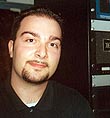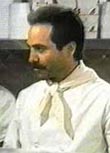|
|
 
|
|
Author
|
Topic: DCM Input Clip
|
|
|
|
|
|
|
|
|
|
|
Steve Guttag
We forgot the crackers Gromit!!!

Posts: 12814
From: Annapolis, MD
Registered: Dec 1999
|
 posted 06-01-2003 06:11 PM
posted 06-01-2003 06:11 PM




This really goes to the DCM's design more than anything. It is your weak link in the audio chain...the first thing that will run out will be the DCM's headroom in the digital domain and that will happen long before most of QSC's amp line will clip (run out of power). As such, you have a bottle-neck going into the DCM.
What QSC really needs to do is to do what RANE has done with their DSP systems (see the RANE RPM-26 series and it associated RANEWARE and DRAGNET software). They provide the installer to see what the level is going into the DSP system...maximize the signal before clipping going into and throughout the Digital domain...then maximize the S/N on the output so you could maximize your S/N on the amps.
Remember anything you do to the signal after you set the gain structure will affect your overall signal....thus if you set you system...then tune it...any boosts in the EQ will come off your headroom and potentially clip the system. Any cuts, while increasing headroom do so at the potential of S/N improvements.
Moving down to the crossover...if, like the DCM, the DSP crossover has EQ within it...that also comes off the DSP headroom. So any "screen loss" or "CD horn compensation" you apply in the crossover will come off the DSP headroom and put you in a clipping situation.
Then next dirty little secret of the DCM/DCA system is its 6-dB hit caused by the design of the "data port" on the amplifiers themselves....yes if you use the data ports (the only way the DCM connects) it is as if you turned down the attenuators by 6-dB as compared to the XLR or phoenix input connectors.
So with the DCM/DCA system you have two hits against you (gain wise)...the DCM clips easily (in the digital domain, and you have no way of knowing just how close to the "cliff" you are coming). Then you have a effectively 6-dB less gain in the amplifier due strictly to the dataport that the DCM uses.
The net result...TURN THE AMPS UP ALL OF THE WAY and pray. You have no control over the system and no way of knowing if you are going to clip it unless you methodically, after tuning, check each input for clipping all of the way up to the maximum level that each channel will be expeceted to play.
You will likely find that for many systems, there is no way to play a film at its maximum level without clipping the DCM.
The only DSP crossover system that I personally like are those that I have worked with by RANE...they let you see what you are doing and virtually eliminate the 1/3rd octave EQ since you can talor the crossover to perfectly match the speaker it is connected to...you also can optimize the gain structure for maximum S/N.
That being said...I'll use an analog crossover everytime if I can get away with it...more reliable and, to my ears, often better sounding with FAR less hassles. The QSC XC-3 are decent enough crossovers (and the SF-3 subwoofer filter is too). And, of course, I also recommend Rane's AC22B and AC23B are excellent choices too.
Steve
| IP: Logged
|
|
|
|
|
|
Nathan Tarpley
Film Handler
Posts: 12
From: Crystal Lake, IL
Registered: Sep 2007
|
 posted 11-04-2007 10:40 AM
posted 11-04-2007 10:40 AM



Time to dredge up this topic to inquire about the new DCMs. (10, 10D, 30, 30D).
Has anyone installed any of these? Have they improved the design to accommodate more headroom? I noticed that the dataport output spec has gone up from 99dB to 103dB according to the literature. The maximum analog input spec is still listed at +14.2dBu. There is quite a bit more flexibility in the parametric EQ now, (which might be a bad thing, depending on your perspective) three bands per section (i.e. up to nine bands of EQ on a tri-amp system). Also, instead of simply routing the surround channels to the dataports in the analog domain, they are now included in the DSP and can be EQed.
There is very little info on the spec sheet about the AES/EBU input on the D models. It doesn't even list what bit depths and sampling rates it can accept, i assume its up to 24 bit and 48Khz, which is the maximum a 650 with the cat.778 digital I/O board can output.
Also, Steve, I am curious about your statement about dataport input on the DCA. Did you mean to say that the the 6dB hit is on the output of the DCM? Since the XC-3 and SF-3 also use the dataport input to the amp, do you see the hit when using those crossovers as well?
Nathan
P.S. Antonio, if your careful with it and implement it properly, the "Noise Floor Optimization" feature on the 650 can improve the system's overall s/n performance.
| IP: Logged
|
|
|
|
|
|
All times are Central (GMT -6:00)
|
|
Powered by Infopop Corporation
UBB.classicTM
6.3.1.2
The Film-Tech Forums are designed for various members related to the cinema industry to express their opinions, viewpoints and testimonials on various products, services and events based upon speculation, personal knowledge and factual information through use, therefore all views represented here allow no liability upon the publishers of this web site and the owners of said views assume no liability for any ill will resulting from these postings. The posts made here are for educational as well as entertainment purposes and as such anyone viewing this portion of the website must accept these views as statements of the author of that opinion
and agrees to release the authors from any and all liability.
|

 Home
Home
 Products
Products
 Store
Store
 Forum
Forum
 Warehouse
Warehouse
 Contact Us
Contact Us




 Printer-friendly view of this topic
Printer-friendly view of this topic






![[Wink]](wink.gif)

![[Smile]](smile.gif) I cannot understand how setting all the amps up can be the winner procedure in ALL situations. Let me explain.
I cannot understand how setting all the amps up can be the winner procedure in ALL situations. Let me explain.



